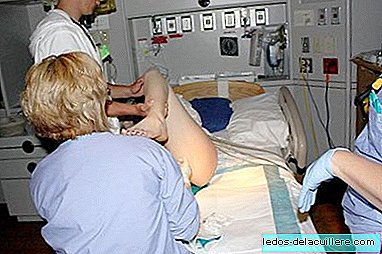
A few days ago a mom posted a picture of her with her two newborn twins on Facebook. One of them had a pink appearance, pulling red, and the other a much paler appearance. Next to the photo came his explanation, saying that one of them had his cord cut as soon as he was born and that in the case of the other it took a few minutes.
The babies were born naturally, in good health and were delivered to the mother who stayed with them in the chest. Which of them had the cord cut later?
The mother asked for diffusion because she considered that it was very representative to see the difference in the skin of the little ones. The baby on the left, as you may have imagined, was the one who separated before his mother. The one on the right, who has such a good color, received more blood because the cord was beating for a while after birth.
When should the umbilical cord be cut?
As we explained a year ago, when we review the bibliography about the best time to cut the umbilical cord, the ideal is that it be until the cord stops beating or until at least 2 to 3 minutes have passed.
During the first minute after birth the baby receives 80 ml of blood, which becomes 100 ml when it reaches 3 minutes. Those 100 ml of extra blood seem little, but for a baby it's very much. Keep in mind that a newborn has between 80 and 110 ml of blood per kg of weight. A 3 kg baby is born with between 240 and 330 ml of blood, so 100 ml more is a third more blood volume.
This extra blood causes that of the 75 mg of iron per kilo of weight with which a baby is born happens to have about 115-125 mg / kg. To more iron, harder it will be for that baby to have anemia In the first year of life.
If we talk about more than 3 minutes to cut the cord we can enter an unwanted phase, since the volume of blood that passes from the placenta to the baby is already very low and however the risk of jaundice begins to increase. That is why it is recommended that it be cut about 2-3 minutes, which is apparently when they cut the baby on the right of the photo.
But my baby's cord was cut right away and it wasn't so white
I thought that when I saw the picture, and it's true ... but hey, we haven't all had twins, right? Rose, the mother of the two creatures, sent a new photo (below) of the two babies, three hours after being born, in which it is seen that the baby on the left already had a better color, but that in comparison it was still a little more white

I came to think that during pregnancy the baby on the right was more "matched" than the one on the left, what we know as twin to twin transfusion syndrome, or fetal syndrome, which is what happens when the blood supply that goes to one of the twins passes to the other through the placenta they share. One of them is born larger and pink, with more blood volume, and the other is paler and smaller. The mother, however, has confirmed that this is not the case.
So, as a picture is worth a thousand words, serve this image to show how important it can be to wait a couple of minutes or three before clamping the umbilical cord.












